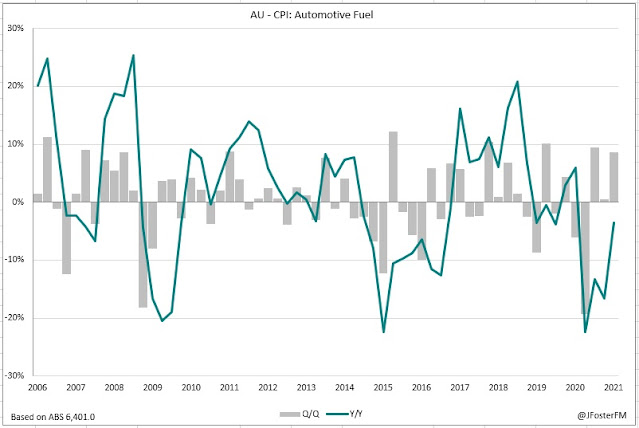Australia's Consumer Price Index (CPI) came in weaker than expected across all key readings in the March quarter. Policy-related effects are creating a lot of volatility within the data, but there is little to indicate that a strong economic rebound is leading to broad-based underlying inflationary pressures.
Consumer Price Index — Q1 | By the numbers
- Headline CPI (not seasonally adjusted) was softer than expected at 0.6% in Q1 against the median estimate of 0.9% and was down from 0.9% in Q4. Annual CPI firmed to 1.1% from 0.9% but was below the 1.4% rate expected. Seasonally adjusted CPI softened to 0.5% in Q1 (from 0.9% in Q4), leaving the annual pace little changed at around 1%.
- Details for the underlying measures (measures are seasonally adjusted);
- Trimmed mean lifted 0.35%q/q, coming in well below the 0.6% pace expected, while the annual pace eased to 1.09% from 1.17%.
- Weighted median increased by 0.42%q/q as the pace through the year held around 1.3%.
Consumer Price Index — Q1 | The details
Headline inflation was muted in the March quarter at 0.6%, much slower than the rises in the previous two quarters (1.6% in Q3 and 0.9% in Q4). The RBA's preferred measure of inflation has remained broadly unchanged over the period of the reopening, with the trimmed mean printing at 0.35% in the quarter as the annual pace softened slightly to around 1.1%. A range of policy impacts continues to push and pull the inflation data and base effects, which will kick in next quarter, will drive the pace of inflation higher, but there remains little to suggest that these effects will prove anything more than transitory. Goods-related inflation soared at the onset of the pandemic due to shifts in consumption patterns with many services becoming unavailable, but it may have peaked after it rolled over in Q1 to 2.8%Y/Y from 3.4%. Services inflation has picked up to 0.7%Y/Y but is still weak considering the extent of the reopening.
The main influence on headline inflation in the quarter was from higher petrol prices, with automotive fuel up by 8.7% in Q1 in response to the rebound in global oil prices post lockdowns, but it is still 3.6% lower than a year earlier. This added a little more than 0.3ppt to headline inflation, accounting for most of the 0.38ppt contribution from the transport group.
Prices for the health group advanced by 2.0% in Q1 to be 3.0% higher through the year. Increases in the group included a 1.5% rise for medical and hospital services due to the January 1 reset for the PBS and Medicare safety net thresholds, and a 4.7% rise in medical products, appliances and equipment.
The key housing group, which contains the two largest individual items by weight in the CPI, lifted by 0.1% in Q1 to be 1.1% lower through the year. Despite strong demand for new homes in response to policy stimulus, new dwelling costs were recorded to have declined by 0.1% in the quarter, partially retracing the 0.7% boost in Q4. The ABS notes that this was a consequence of the Federal Government's HomeBuilder grants, which in the absence of the scheme would have led to new dwelling prices surging by 1.9% in the quarter. Rents were hit hard by elevated vacancies due to the border closures and introduction of rent reduction mechanisms at the onset of the pandemic but have held flat over the past two quarters. Household utilities fell further in the quarter (-0.2%) and are sharply lower than a year earlier (-7.4%) reflecting the impact of government rebates to support households through the pandemic.
Prices across the furnishings, household equipment and services group fell slightly in Q1 (-0.2%) as post-Christmas sales led to discounting for furniture (-3.0%). However, furniture prices were still 5.9% higher through the year after demand for home office equipment surged due to the lockdowns. Meanwhile, the unwinding of free child care services has seen prices there return to above pre-pandemic levels after rising by 2.2% in Q1.
There were a couple of downside surprises in today's report. Recreation and culture fell by 0.2%q/q on the back of a 1.8% slide in domestic travel costs. While the reopening of state borders led to increased demand for accommodation and higher hotel prices, this was more than offset by discounting by the airlines. Meanwhile, the alcohol and tobacco group posted its slowest quarterly outcome in 2 years (0.3%) as a 0.6% fall in tobacco, with no tax excise increase being applied, moderated a 1.0% rise in alcohol prices.
Consumer Price Index — Q1 | Insights
Pandemic -and policy-related effects continue to push and pull on the inflation data but the main takeaway is that the underlying pulse is still very soft. Despite the economy rebounding sharply since the reopening, inflation that is well below target will allow the RBA to keep its foot to the floor with its very accommodative policy settings. Inflation will spike higher next quarter on base effects, though the Board has repeatedly said that it expects this to be transitory and will weaken soon after reflecting the level of spare capacity in the economy and slow wages growth.









